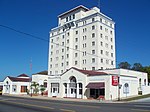St. Mark's Episcopal Church (Haines City, Florida)
1890 establishments in FloridaCarpenter Gothic church buildings in FloridaChurches completed in 1890Churches in Polk County, FloridaChurches on the National Register of Historic Places in Florida ... and 6 more
Episcopal church buildings in FloridaFlorida church stubsHaines City, FloridaNational Register of Historic Places in Polk County, FloridaPolk County, Florida Registered Historic Place stubsUnited States Anglican church stubs

St. Mark's Episcopal Church, located at 102 North 9th Street in Haines City, Florida is an historic Carpenter Gothic church. On March 17, 1994, it was added to the U.S. National Register of Historic Places.
Excerpt from the Wikipedia article St. Mark's Episcopal Church (Haines City, Florida) (License: CC BY-SA 3.0, Authors, Images).St. Mark's Episcopal Church (Haines City, Florida)
North 8th Street,
Geographical coordinates (GPS) Address Nearby Places Show on map
Geographical coordinates (GPS)
| Latitude | Longitude |
|---|---|
| N 28.108055555556 ° | E -81.625 ° |
Address
North 8th Street 98
33844
Florida, United States
Open on Google Maps







